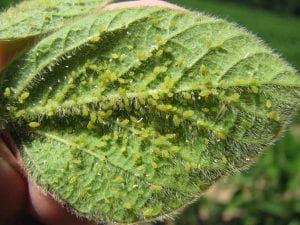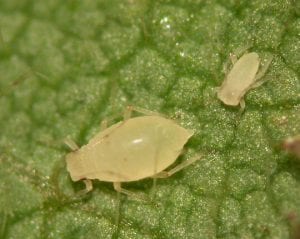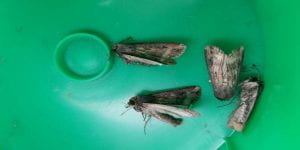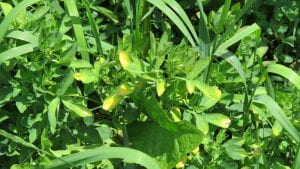NYS IPM Weekly Field Crops Pest Report-June 30, 2022
Willsboro Research Farm Open House
Willsboro, NY – June 16, 2022
The Cornell University Willsboro Research Farm will hold an open house on Thursday, July 7 from 1:30pm to 4:00pm. A tour of the facilities and research plots will leave the main office (48 Sayward Lane, Willsboro) at 2:00pm. Light refreshments will be provided.
Research topics featured at this year’s open house include early season high tunnel broccoli and cabbage production, strawberry growing systems, alternatives to neonic seed treatments, corn silage variety evaluations, a grain corn variety trial, soil health plots, a canopy sensing robot, cover crops, male sterile forage sorghum, juneberry nursery and production trials, Aronia variety plantings, a honeyberry variety trial, and forage and grain plots of winter triticale and winter rye.
In 1982 E. Vreeland Baker, a Willsboro farmer and entrepreneur, donated his 352-acre farm to Cornell University for agricultural research and demonstration. The facility serves to connect Cornell faculty in Ithaca with the challenges and issues facing North Country farmers. The Willsboro Research Farm is part of the Cornell University Agricultural Experiment Station.
This event is free and open to the public. For more information call 518-963-7492.
Michael Davis- Research Associate
Cornell University Willsboro Research Farm
48 Sayward Lane
Willsboro, NY 12996
mhd11@cornell.edu
Soybean Aphids
Soybean aphids have been reported at high infestation rates on a few fields in western NY. This is most likely the 1st generation of soybean aphids migrating off buckthorn. Buckthorn species (Rhamnus spp) are the overwintering host of soybean aphids. The soybeans with high infestation rates were the beans that did not have and insecticide seed treatment. A few of these fields were sprayed to control the aphids.
For more information view the following website:
https://cals.cornell.edu/field-crops/soybeans/insects-soybeans/soybean-aphid.
Field Corn Pheromone Trapping Network
We will be transitioning from black cutworm and true armyworm to western bean cutworm and fall armyworm in the next few weeks. The interactive map will include all of these captures as well. We are including fall armyworm because of the amount of damage it had done later in the season last year.
Potato Leafhopper in Alfalfa
Potato leafhopper has migrated to NYS on the storms we have received. They overwinter in the southern US and travel north in late May into June. They have been laying eggs and the nymphs will emerge soon. Nymphs do most of the damage to alfalfa because they can occur at very high infestation rates. To avoid damage start scouting for this pest. If you see the V-shaped yellowing of the leaf tips, it is too late. The damage to yield and quality has happened. For thresholds, please view the following site: https://cals.cornell.edu/field-crops/forages/insects-forage-crops/potato-leafhopper
Black cutworm in Field Corn
There was one more intense catch with black cutworm this last week in Seneca Falls. The black cutworm season is about over even if we continue to get flights of moths. Once the corn reaches the V6 stage of growth black cutworm does not continue to feed. If the corn is younger than V6, it is best to get out and scout fields. The threshold is 5% or more of the plants have been cut is the point to employ management. For more information, please few the following website:
Black Cutworm
https://cals.cornell.edu/field-crops/corn/insects-corn/cutworms
Interactive Field Corn Pheromone Moth Trapping Network Map
Black Cutworm Degree Day Accumulations by Location through June 30, 2022
| *Location for Intense Catches |
Black Cutworm (Base 50) |
Life Stage |
|
Seneca Falls Seneca County April 26 25 Moths Caught |
—– |
Pupate No More Feeding |
|
Avon Livingston County May 12 23 Moths Caught |
—- |
Pupate No More Feeding |
|
Rush Monroe County May 15 39 Moths Caught |
—- |
Pupate No More Feeding |
|
Hounsfield Jefferson County May 16 25 Moths Caught |
611 |
Cutting Corn Plants 6th Instar |
|
Casterland Lewis County May 16 23 Moths Caught |
611 |
Cutting Corn Plants 6th Instar |
|
Canton St Lawrence May 16 37 Moths Caught |
497 |
Cutting Corn Plants 6th Instar |
|
Seneca Falls Seneca County May 22 23 Moths Caught |
—- |
Pupate No More Feeding |
|
Munnsville Madison County May 29 27 Months Caught |
564 |
Cutting Corn Plants 6th Instar |
|
Housnfield Jefferson County May 22 25 Moths Caught |
561 |
Cutting Corn Plants 6th Instar |
|
Martinsburg Lewis County May 22 23 Moths Caught |
561 |
Cutting Corn Plants 6th Instar |
|
Farmington Ontario County May 29 23 Moths Caught |
554 |
Cutting Corn Plants 6th Instar |
|
Martinsburg Lewis County May 29 19 Moths Caught |
478 |
Cutting Corn Plants 6th Instar |
|
Oxford Chenango County May 29 15 Moths Caught |
564 |
Cutting Corn Plants 6th Instar |
|
Munsville Madison County May 31 20 Moths Caught |
527 |
Cutting Corn Plants 6th Instar |
|
Sterling Cayuga County June 5 16 Moths |
441 |
Cutting Corn Plants 6th Instar |
|
Skaneateles Onondaga County June 5 22 Moths Caught |
441 |
Cutting Corn Plants 6th Instar |
|
Cato Cayuga County June 5 26 Moths |
441 |
Cutting Corn Plants 6th Instar |
|
West Sparta Livingston County June 12 17 moths |
350 |
Cutting Corn Plants 4th Instar |
|
Rush Monroe County June 12 35 moths |
369 |
Cutting Corn Plants 5th Instar |
|
Springport Cayuga County June 19 18 moths |
226 |
Leaf Feeding 1-3 Instar |
|
Seneca Falls Seneca County June 19 45 Moths |
226 |
Leaf Feeding 1-3 Instar |
|
Hounsfield Jefferson County June 26, 2022 21 Moths |
85 | Laying Eggs |
|
Seneca Falls Seneca County June 28 31 Moths |
42 | Laying Eggs |
*Intense Catch is over 15 moths in a week.
Black Cutworm Degree Days (Base 500 F) Lifecycle Growth Stages
Degree Days Stage Feeding Activity
0 Moth Capture Egg Laying
90 Eggs Hatch
91-311 1st to 3rd Instar Leaf Feeding
312-364 4th Instar Cutting Begins
365-430 5th Instar Cutting Begins
431-640 6th Instar Cutting Slows
641-989 Pupa No feeding






